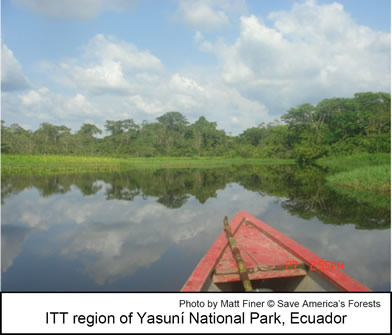| Save America's Forests | Donate-Join | Yasuní Rainforest Campaign | | ||||
| Home | News | Oil & Biodiversity maps | Oil & Gas block databases | Contact us |
|
CONTACT:
Experts Evaluate Bold Ecuadorian Initiative to Leave Oil Locked Under the Amazon Ecuador is pursuing an innovative proposal to leave nearly one billion barrels of oil locked beneath the Amazon rainforest. Experts from the World Resources Institute, Save America´s Forests, and the University of Maryland put this proposal under the microscope in a new article in the scientific journal Biotropica (click for journal site).
The Ecuadorian proposal, known as the Yasuní-ITT Initiative, has been widely lauded for its three-pronged effort to protect biodiversity, respect indigenous peoples’ territory, and combat climate change. The study details how the oil fields lie beneath the core of Yasuní National Park—one of the most biodiverse parts of the Amazon—and within the territory of some of the world’s last uncontacted indigenous peoples, the Tagaeri and Taromenane. In addition, the authors describe the proposal as the first ever offer by a government to forego oil development as a strategy to address climate change. According to Ecuadorian officials, not exploiting the ITT fields will keep 410 million metric tons of CO2 out of the atmosphere. However, the Yasuní-ITT Initiative has not won universal praise and the article confronts the toughest questions surrounding the Ecuadorian proposal. For example, how to pay for the effort is in question. Ecuador, a country highly dependent on oil export revenues, seeks $350 million for each of the next 10 years in alternative revenue. Ecuador’s intent is to sell certificates linked to the value of the unreleased carbon. This raises a number of technical questions, however, such as the possibility that the initiative would not result in a net global CO2 reduction if the certificates were traded in carbon markets. “The best way to minimize the risk associated with the carbon bonds is to encourage supporters to make direct donations,” said Remi Moncel of the World Resources Institute. “While less problematic from the point of view of environmental integrity, it is harder to raise money that way.” Germany, the leading supporter of the Yasuní-ITT Initiative, indeed seems to be following this route. Recent reports indicate that Germany will donate $70 million annually to the initiative. Additional challenging questions tackled in the study include why a national park is on the chopping block in the first place and what mechanisms are needed to prevent future Ecuadorian administrations from drilling the oil fields. The authors conclude that the Yasuní-ITT Initiative, with its focus on generating alternative revenue, is a potentially precedent-setting advance in avoiding damaging oil and gas development in sensitive areas. “Yasuní is an exceptional place in the world, biologically incredible, home to uncontacted peoples, and yet – perhaps tragically – full of oil,” said Dr. Clinton Jenkins of the University of Maryland. “Society faces a test of what we value more, drilling for more oil, or preserving a cherished national park and the people who call it home.” The authors also conclude that the initiative represents an innovative way to address climate change. “The climate conference of Copenhagen is only weeks away. What Ecuador has proposed is a good example of how each country can come up with home-grown, nationally relevant ideas to promote sustainable development,” said Moncel. Authors Finer and Jenkins recently published a companion study entitled, “Ecuador’s Yasuní Biosphere Reserve: a brief modern history and conservation challenges.” It is a concise history of the Yasuní region designed to help people better understand this complicated part of the world. That article appeared in Environmental Research Letters http://www.iop.org/EJ/abstract/1748-9326/4/3/034005 For more information on the ITT proposal, also see http://www.saveamericasforests.org/Yasuni/ITT-Links.htm
|
||||
| Site maintained by Clinton Jenkins and Save America's Forests | ||||

 “Oil and gas concessions now cover vast swaths of the mega-diverse western Amazon,” said lead author Dr. Matt Finer of Save America’s Forests. “Ecuador´s revolutionary initiative is the first major government-led effort to buck this disturbing trend.”
“Oil and gas concessions now cover vast swaths of the mega-diverse western Amazon,” said lead author Dr. Matt Finer of Save America’s Forests. “Ecuador´s revolutionary initiative is the first major government-led effort to buck this disturbing trend.”